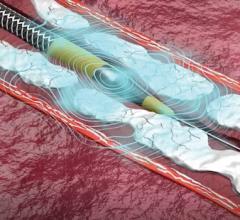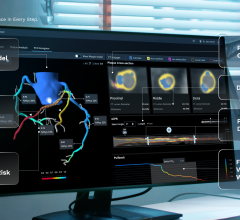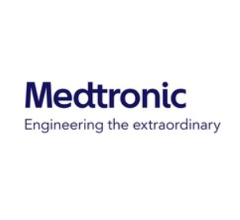
Illustration showing the self-expanding deployment of the Vici stent in the iliofemoral vein.


May 6, 2019 — The U.S Food and Drug Administration (FDA) has cleared the Boston Scientific Vici Venous Stent System for the treatment of iliofemoral venous obstructive disease. These blockages occur when the flow of blood through the veins located deep in the pelvic region becomes blocked by a blood clot or compressed by anatomical anomalies.
The self-expanding, nitinol stent is specifically designed to meet the challenges of venous anatomy. It uses a unique closed-cell geometry that offers high radial strength to prop vessels open in a circular lumen without compromising flexibility or deployment accuracy.
Venous obstructive disease affects nearly 40 percent of the population in the U.S. and can be caused by conditions such as deep vein thrombosis (DVT), post-thrombotic syndrome (PTS) and compressive diseases such as May-Thurner syndrome. In patients with venous obstructions, blood may pool in the legs, resulting in pain, swelling and skin ulcers.
Endovascular treatment for venous obstructive disease is focused on restoring the normal flow of blood from the legs back to the heart. The iliofemoral veins are located deep in the pelvis and may be subject to significant crushing forces from other anatomical structures such as the right common iliac artery. To help solve for this, the Vici stent system was specifically designed to be uniformly strong and crush resistant, capable of restoring blood blow by creating a cylindrical, patent vessel.
"For those suffering from venous obstructive disease, their quality of life may suffer without treatment options optimized for the disease," said Mahmood Razavi, M.D., St. Joseph Hospital, Orange, Calif. "With the approval of the Vici stent, clinicians now have access to a stent that was purposely developed and engineered to resist the vessel compression and anatomical tortuosity commonly found within the iliofemoral venous system, enabling our ability to deliver best outcomes for our patients."
FDA Approval Based on the VIRTUS study
The approval of the Vici stent was based on data from the VIRTUS study, a prospective, multi-center, single-arm study with 170 patients. The VIRTUS study evaluated the Vici stent in relation to pre-defined objective performance goals in patients with a clinically significant obstruction in the illiofemoral venous outflow tract. It successfully met its primary safety and effectiveness endpoints.
"The FDA approval of the Vici venous stent system is the latest example of our commitment to building the most comprehensive portfolio of technologies specifically developed to meet the needs of physicians treating both chronic and acute venous disease," said Jeff Mirviss, senior vice president and president, peripheral interventions, Boston Scientific. "We are pleased to provide this differentiated stent system to U.S. patients suffering from debilitating deep venous disease."
The Vici stent system received CE mark in 2013. The device was developed by Veniti Inc., which Boston Scientific acquired in August of 2018.
View videos on how the stent works and interviews with a patient and Razavi.
Related Content:
Boston Scientific to Acquire Veniti Inc.
Veniti Announces Boston Scientific Distribution Agreement for Vici Venous Stent
First U.S. Patients Enrolled in Virtus Trial for Venous Stenting
First Uses of Veniti Vici Venous Stent System Reported
Veniti Completes First Use of Novel Venous Stent System
Boston Scientific Invests $25 Million in Veniti Venous Stent
Late-Breaking Endovascular Clinical Trial Results Announced At VIVA 16


 November 14, 2025
November 14, 2025 









